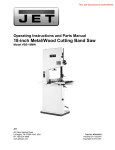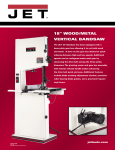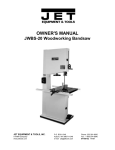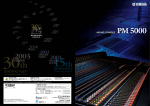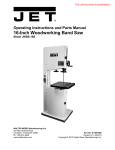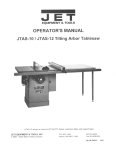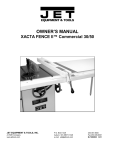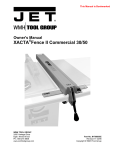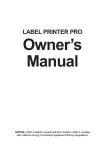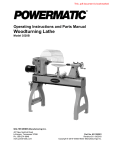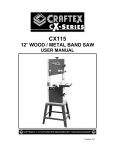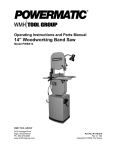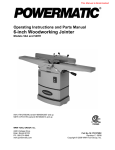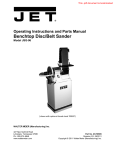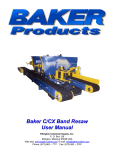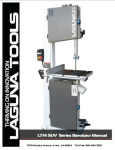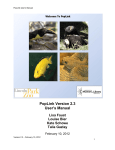Download 18-inch Band Saw
Transcript
This .pdf document is bookmarked Operating Instructions and Parts Manual 18-inch Band Saw Model PM1800 WALTER MEIER (Manufacturing) Inc. 427 New Sanford Rd. LaVergne, TN 37086 Ph.: 800-274-6848 www.powermatic.com Part No. M-1791800 Revision A4 06/2010 Copyright © 2010 Walter Meier (Manufacturing) Inc. Warranty and Service Walter Meier (Manufacturing) Inc., warrants every product it sells. If one of our tools needs service or repair, one of our Authorized Service Centers located throughout the United States can give you quick service. In most cases, any of these Walter Meier Authorized Service Centers can authorize warranty repair, assist you in obtaining parts, or perform routine maintenance and major repair on your POWERMATIC® tools. For the name of an Authorized Service Center in your area call 1-800-274-6848. MORE INFORMATION Walter Meier is consistently adding new products to the line. For complete, up-to-date product information, check with your local Walter Meier distributor, or visit powermatic.com. WARRANTY POWERMATIC products carry a limited warranty which varies in duration based upon the product. WHAT IS COVERED? This warranty covers any defects in workmanship or materials subject to the exceptions stated below. Cutting tools, abrasives and other consumables are excluded from warranty coverage. WHO IS COVERED? This warranty covers only the initial purchaser of the product. WHAT IS THE PERIOD OF COVERAGE? The general POWERMATIC warranty lasts for the tim e period specified in the product literature of each product. WHAT IS NOT COVERED? The Five Year Warranty does not cover products used for commercial, industrial or educational purposes. Products with a Five Year Warranty that are used for commercial, industrial or education purposes revert to a One Year Warranty. This warranty does not cover defects due directly or indirectly to misuse, abuse, negligence or accidents, normal wear-and-tear, improper repair or alterations, or lack of maintenance. HOW TO GET SERVICE The product or part must be returned for examination, postage prepaid, to a location designated by us. For the name of the location nearest you, please call 1-800-274-6848. You must provide proof of initial purchase date and an explanation of the complaint must accompany the merchandise. If our inspection discloses a defect, we will repair or replace the product, or refund the purchase price, at our option. We will return the repaired product or replacement at our expense unless it is determined by us that there is no defect, or that the defect resulted from causes not within the scope of our warranty in which case we will, at your direction, dispose of or return the product. In the event you choose to have the product returned, you will be responsible for the handling and shipping costs of the return. HOW STATE LAW APPLIES This warranty gives you specific legal rights; you may also have other rights which vary from state to state. LIMITATIONS ON THIS WARRANTY WALTER MEIER (MANUFACTURING) INC., LIMITS ALL IMPLIED WARRANTIES TO THE PERIOD OF THE LIMITED WARRANTY FOR EACH PRODUCT. EXCEPT AS STATED HEREIN, ANY IMPLIED WARRANTIES OR MERCHANTABILITY AND FITNESS ARE EXCLUDED. SOME STATES DO NOT ALLOW LIMITATIONS ON HOW LONG THE IMPLIED WARRANTY LASTS, SO THE ABOVE LIMITATION MAY NOT APPLY TO YOU. WALTER MEIER (MANUFACTURING) INC., SHALL IN NO EVENT BE LIABLE FOR DEATH, INJURIES TO PERSONS OR PROPERTY, OR FOR INCIDENTAL, CONTINGENT, SPECIAL, OR CONSEQUENTIAL DAMAGES ARISING FROM THE USE OF OUR PRODUCTS. SOME STATES DO NOT ALLOW THE EXCLUSION OR LIMITATION OF INCIDENTAL OR CONSEQUENTIAL DAMAGES, SO THE ABOVE LIMITATION OR EXCLUSION MAY NOT APPLY TO YOU. Walter Meier sells through distributors only. The specifications in Walter Meier catalogs are given as general information and are not binding. Members of Walter Meier reserve the right to effect at any time, without prior notice, those alterations to parts, fittings, and accessory equipment which they may deem necessary for any reason whatsoever. 2 Table of Contents Warranty and Service..........................................................................................................................2 Table of Contents ...............................................................................................................................3 Warning .............................................................................................................................................5 Introduction ........................................................................................................................................7 Specifications .....................................................................................................................................7 Features and Terminology ...................................................................................................................8 Unpacking ..........................................................................................................................................9 Installation........................................................................................................................................ 10 Assembly ......................................................................................................................................... 10 Rear Rail ...................................................................................................................................... 10 Front Rail and Guide Tube ............................................................................................................. 11 Fence Assembly............................................................................................................................ 11 Resaw Fence ................................................................................................................................ 11 Fence to Table Clearance .............................................................................................................. 12 Setting Cursor (Zero) Position ........................................................................................................ 12 Setting Table Parallel to Blade ....................................................................................................... 12 Setting Fence Parallel to Blade ...................................................................................................... 13 Fence Locking Tightness ............................................................................................................... 13 Dust Collection ................................................................................................................................. 14 Electrical Connections....................................................................................................................... 14 Extension Cords ............................................................................................................................ 15 Adjustments ..................................................................................................................................... 15 Table Tilt....................................................................................................................................... 15 90° Table Stop .............................................................................................................................. 15 Installing/Changing Blades ............................................................................................................. 16 Blade Tension ............................................................................................................................... 17 Blade Tracking .............................................................................................................................. 18 Upper Blade Guides ...................................................................................................................... 19 Upper Thrust Bearing .................................................................................................................... 20 Lower Blade Guides ...................................................................................................................... 20 Guide Post .................................................................................................................................... 21 Guide Post Parallelism................................................................................................................... 21 Resaw Pin .................................................................................................................................... 22 Miter Gauge .................................................................................................................................. 22 Blade Speed Adjustment................................................................................................................ 23 Drive Belt Tension and Replacement .............................................................................................. 23 Wheel Brush ................................................................................................................................. 24 Insert Block ................................................................................................................................... 24 Operating Controls............................................................................................................................ 24 Safety Key .................................................................................................................................... 25 Brake Pedal .................................................................................................................................. 25 Operation ......................................................................................................................................... 26 General Procedure ........................................................................................................................ 26 Resawing...................................................................................................................................... 27 Blade Lead ................................................................................................................................... 27 Ripping ......................................................................................................................................... 26 Crosscutting .................................................................................................................................. 26 Blade Selection ................................................................................................................................ 29 Width ............................................................................................................................................ 29 Pitch ............................................................................................................................................. 29 Shape........................................................................................................................................... 29 Set ............................................................................................................................................... 30 Material ........................................................................................................................................ 30 Blade Breakage............................................................................................................................. 30 Blade Selection Guide....................................................................................................................... 31 Troubleshooting – Operational Problems ............................................................................................ 32 Troubleshooting – Mechanical and Electrical Problems ....................................................................... 34 3 Replacement Parts ........................................................................................................................... 35 Upper Wheel Assembly – Exploded View........................................................................................ 36 Upper Wheel Assembly – Parts List ................................................................................................ 37 Lower Wheel and Motor Assembly – Exploded View ........................................................................ 38 Lower Wheel and Motor Assembly – Parts List ................................................................................ 39 Blade Guide Assembly – Exploded View ......................................................................................... 41 Blade Guide Assembly – Parts List ................................................................................................. 42 Table and Fence Assembly – Exploded View .................................................................................. 44 Table and Fence Assembly – Parts List .......................................................................................... 45 Electrical Connections – 5HP 1PH 230V ............................................................................................ 47 Electrical Connections – 5HP 3PH 230V ............................................................................................ 48 Electrical Connections – 5HP 3PH 460V ............................................................................................ 49 4 Warning 1. Read and understand the entire owner’s manual before attempting assembly or operation. 2. Read and understand the warnings posted on the machine and in this manual. Failure to comply with all of these warnings may cause serious injury. 3. Replace the warning labels if they become obscured or removed. 4. This band saw is designed and intended for use by properly trained and experienced personnel only. If you are not familiar with the proper and safe operation of a band saw, do not use until proper training and knowledge have been obtained. 5. Do not use this band saw for other than its intended use. If used for other purposes, Walter Meier (Manufacturing) Inc., disclaims any real or implied warranty and holds itself harmless from any injury that may result from that use. 6. Always wear approved safety glasses/face shields while using this band saw. Everyday eyeglasses only have impact resistant lenses; they are not safety glasses. 7. Before operating this band saw, remove tie, rings, watches and other jewelry, and roll sleeves up past the elbows. Secure all loose clothing and confine long hair. Non-slip footwear or anti-skid floor strips are recommended. Do not wear gloves when operating the machine. 8. Wear ear protectors (plugs or muffs) during extended periods of operation. 9. Some dust created by power sanding, sawing, grinding, drilling and other construction activities contains chemicals known to cause cancer, birth defects or other reproductive harm. Some examples of these chemicals are: • • Lead from lead based paint. Crystalline silica from bricks, cement and other masonry products. • Arsenic and chromium from chemically treated lumber. Your risk of exposure varies, depending on how often you do this type of work. To reduce your exposure to these chemicals, work in a well-ventilated area and work with approved safety equipment, such as face or dust masks that are specifically designed to filter out microscopic particles. 10. Do not operate this machine while tired or under the influence of drugs, alcohol or any medication. 11. Make certain the switch is in the OFF position before connecting the machine to the power supply. 12. Make certain the machine is properly grounded. 13. Make all machine adjustments or maintenance with the machine unplugged from the power source. 14. Remove adjusting keys and wrenches. Form a habit of checking to see that keys and adjusting wrenches are removed from the machine before turning it on. 15. Keep safety guards in place at all times when the machine is in use. If removed for maintenance purposes, use extreme caution and replace the guards immediately after maintenance is complete. 16. Make sure the band saw is firmly secured to the floor or bench before use. 17. Check damaged parts. Before further use of the machine, a guard or other part that is damaged should be carefully checked to determine that it will operate properly and perform its intended function. Check for alignment of moving parts, binding of moving parts, breakage of parts, mounting and any other conditions that may affect its operation. A guard or other part that is damaged should be properly repaired or replaced. 18. Provide for adequate space surrounding work area and non-glare, overhead lighting. 19. Keep the floor around the machine clean and free of scrap material, oil and grease. 20. Keep visitors a safe distance from the work area. Keep children away. 5 21. Make your workshop child proof with padlocks, master switches or by removing starter keys. 22. Give your work undivided attention. Looking around, carrying on a conversation and “horse-play” are careless acts that can result in serious injury. 23. Maintain a balanced stance at all times so that you do not fall or lean against the blade or other moving parts. Do not overreach or use excessive force to perform any machine operation. 24. Adjust the upper guides to approximately 3/16” above the workpiece. 25. Make relief cuts when sawing curves. 26. Use the right tool at the correct speed and feed rate. Do not force a tool or attachment to do a job for which it was not designed. The right tool will do the job better and more safely. 27. Use recommended accessories; improper accessories may be hazardous. 28. Maintain tools with care. Keep blades sharp and clean for the best and safest performance. Follow instructions for lubricating and changing accessories. 29. Turn off the machine and disconnect from power before cleaning. Use a brush or compressed air to remove chips or debris — do not use your hands. 30. Do not stand on the machine. Serious injury could occur if the machine tips over. 31. Never leave the machine running unattended. Turn the power off and do not leave the machine until it comes to a complete stop. 32. Remove loose items and unnecessary work pieces from the area before starting the machine. Familiarize yourself with the following safety notices used in this manual: This means that if precautions are not heeded, it may result in minor injury and/or possible machine damage. This means that if precautions are not heeded, it may result in serious injury or possibly even death. - - SAVE THESE INSTRUCTIONS - - 6 Introduction This manual is provided by Walter Meier (Manufacturing) Inc., covering the safe operation and maintenance procedures for a Powermatic Model PM1800 Band Saw. This manual contains instructions on installation, safety precautions, general operating procedures, maintenance instructions and parts breakdown. This machine has been designed and constructed to provide years of trouble free operation if used in accordance with instructions set forth in this manual. If there are any questions or comments, please contact either your local supplier or Walter Meier. Walter Meier can also be reached at our web site: www.waltermeier.com. Specifications Model Number ......................................................................................................................... PM1800 Stock Number (5HP 1PH) ........................................................................................................1791800 Stock Number (5HP 3PH) ........................................................................................................1791801 Motor (1PH) .................................................................................... TEFC, 5HP, 1PH, 230V, 60Hz, 21A Motor (3PH) ...........................................................TEFC, 5HP, 3PH, 230/460V (pre-wired 230V)*, 60Hz Blade Speeds (SFPM) ................................................................................................... 1800 and 4200 Maximum Cutting Height/Resaw Capacity (in.) ................................................................................... 18 Throat Capacity (in.) ......................................................................................................................... 18 Minimum Blade Width (in.) ............................................................................................................. 1/16 Maximum Blade Width (in.)............................................................................................................ 1-1/2 Blade Length (in.) ........................................................................................................... 160 to 161-1/2 Blade provided (in.) ...........................................................................Hook Type, 3/4 W x 0.03 Thk, 4TPI Resaw Fence (L x H)(in.)........................................................................................................ 30 x 6-1/2 Resaw Pin (Dia. x H)(in.) ..........................................................................................................2 x 6-1/2 Table Dimensions (L x W x Thk)(in.) ..................................................................................... 24 x 24 x 2 Table Thickness (in.)........................................................................................................................... 2 Table Tilt (deg.) ..............................................................................................................45 right, 15 left Table Height from Floor @ 90 deg. (in.)........................................................................................ 37-1/2 Miter Gauge Positive Stops (deg.)........................................................................................... 45 and 90 Wheel Diameter (in.) ................................................................................................................... 18-1/2 Power Transfer ............................................................................................................. poly-V belt drive Switch .............................................................................................magnetic, with power indicator lamp Dust Port Diameter (in.)....................................................................................................................... 4 Dust Collection CFM Required......................................................................................................... 400 Overall Dimensions (L x W x H)(in.) ............................................................................... 38 x 42 x 81-1/2 Net Weight (lbs.) ............................................................................................................................. 806 Shipping Weight (lbs.) ..................................................................................................................... 902 *NOTE: For 460V operation, magnetic switch (part no. PM2000-293C) must be purchased separately and installed. A qualified electrician is recommended. The above specifications were current at the time this manual was published, but because of our policy of continuous improvement, Walter Meier reserves the right to change specifications at any time and without prior notice, without incurring obligations. 7 Features and Terminology Figure 1 8 Contents of the Shipping Container Unpacking 1 1 1 1 1 1 1 1 Open shipping container and check for shipping damage. Report any damage immediately to your distributor and shipping agent. Do not discard any shipping material until the Band Saw is assembled and running properly. Compare the contents of your container with the following parts list and photos to make sure all parts are intact. Missing parts, if any, should be reported to your distributor. Read the instruction manual thoroughly for assembly, maintenance and safety instructions. 1 1 1 Band Saw (not shown) Rip Fence Body Extruded Aluminum Resaw Fence Front Rail Rear Rail Guide Tube Resaw Pin with Locking Knob Hardware Package containing: 10 Hex Cap Screws, 5/16”-18 x 3/4” (AA) 10 Lock Washers, 5/16” (BB) 10 Flat Washers, 5/16” (CC) Miter Gauge Owner's Manual (not shown) Warranty Card (not shown) Figure 2 Read and understand the entire contents of this manual before attempting set-up or operation! Failure to comply may cause serious injury. 9 Installation Tools required for assembly and set up: 7/32” hex (Allen) wrench 6mm hex (Allen) wrench 12mm open-end wrench Square Hoist or forklift, with straps Remove all crating and plastic from around the machine. Remove any screws or straps holding the band saw to the shipping pallet. Exercise care when removing the machine from the shipping pallet. Use a hoist or forklift with straps to remove the machine from the pallet. The straps used should have a minimum 1,000 lb. lifting capacity. Do NOT place forks or straps directly beneath the table or against handles or levers - place the straps under the top portion of the frame, as shown in Figure 3. Move the band saw to its permanent location, which should be dry and well lit, with enough space on all sides to handle long stock or perform routine maintenance on the machine. Make sure the floor is able to support the weight of the machine. If desired, the band saw can be secured to the floor using lag screws (not provided) through the four holes in the base. Figure 3 Exposed metal surfaces, such as the table surface and blade guides, have been given a protective coating at the factory. This coating should be removed with a soft cloth moistened with solvent. Do not get solvents near plastic or rubber parts; and do not use an abrasive pad as it may scratch the exposed surfaces. Assembly Figure 4 Rear Rail Refer to Figures 4 and 5. 1. Install the rear rail to the rear edge of the table, using three 5/16-18 x 3/4 hex cap screws (AA), three 5/16 lock washers (BB), and three 5/16 flat washers (CC) as shown. Hand tighten only. 2. The exact distance from rear rail to table top is not important, but the rear rail should be made parallel to the table top. Place a measuring device, such as a combination square (Figure 5) at front and back of the table as shown. Figure 5 10 The measurement should be the same at both ends of the rear rail. Adjust as needed. 3. Tighten the two screws with a 12mm wrench. Front Rail and Guide Tube Refer to Figure 6. 4. Install the front rail to the front edge of the table, using two 5/16-18 x 3/4 hex cap screws (AA), two 5/16 lock washers (BB), and two 5/16 flat washers (CC), through the slotted holes in the rail. Place the screws approximately center of the slots; this can be adjusted later as needed. Tighten the two screws with a 12mm wrench. Figure 6 5. Install the guide tube to the bottom holes in the front rail, using five 5/16-18 x 3/4 hex cap screws (AA), five 5/16 lock washers (BB), and five 5/16 flat washers (CC). Tighten all five screws in the guide tube with a 12mm wrench. Do not overtighten. Figure 7 Fence Assembly Refer to Figures 7 and 8. Place the fence body onto the guide tube (as shown in Figure 8). Raise the fence lever all the way up to install or remove the fence from the guide tube. Midway lever position allows the fence to slide along the guide tube. Lowest lever position locks the fence in place. Resaw Fence Refer to Figures 8 and 9. Figure 8 (resaw fence vertical position) Loosen the lock bar using the knobs, until the lock bar protrudes enough to slide the aluminum resaw fence on from one end, as shown in Figure 8. Re-tighten the knobs. NOTE: The aluminum resaw fence can be installed in one of two positions; vertically (resaw position), as shown in Figure 8; or horizontally as shown in Figure 9. Horizontal position is useful for smaller workpieces. (The zero setting of the cursor can not be used with the horizontal fence position.) Figure 9 (horizontal fence position) 11 Fence to Table Clearance 1. Check the clearance between the table and the bottom of the fence (Figure 10). The fence should not rub against the table surface but be slightly above it. This gap should be the same at the front of the table as it is at the back. 2. If the clearance is not the same, use a combination of the following two adjustments: Figure 10 • With a 7/32” hex wrench, rotate the two nylon adjustment screws (A, Figure 16) the same amount to raise or lower the fence body from the guide tube. Clockwise raises the fence body, counterclockwise lowers. • And/or....Adjust the back end of the fence by loosening one hex nut and tightening the other (A, Figure 11) in order to raise or lower the sliding pad (B, Figure 11) as needed. When the fence-to-table gap is equal, make sure both hex nuts are tightened against the fence body. Figure 11 Setting Cursor (Zero) Position Refer to Figure 12. The fence must be set so that the cursor reads zero at the line of the blade. The resaw fence must be installed on the fence body in vertical position, and the blade must be installed and fully tensioned. 1. Slide the fence flush against the flat of the blade, as shown. (Do not force the fence into the blade so that the blade bends.) 2. If the cursor is not at zero, loosen the two screws and slide it as needed. Then retighten the screws. Figure 12 Setting Table Parallel to Blade Refer to Figures 13 and 14. The table has been aligned by the manufacturer so that the miter slot is parallel to the flat of the blade; it should not require adjustment. However, in the future you may wish to confirm this setting is still accurate. A wide blade is recommended for the procedure. 1. Disconnect band saw from power source. 2. The blade should be fully tensioned and properly tracked (see pages 17 and 18). 3. Place a long straightedge flush against the blade making sure it contacts both front and back of the blade. (Do not deflect the blade by pushing into it.) See Figure 13. Figure 13 12 4. Use a gauge to carefully measure the distance from miter slot to straight edge. Take measurements at both front and back of table – these should be the same. 5. If the miter slot is not parallel to the blade, loosen the four hex cap screws that secure the table to the trunnion (Figure 14 shows three of them), and shift the table as needed until the miter slot is parallel to the blade. 6. Tighten the four hex cap screws. Setting Fence Parallel to Blade Refer to Figures 15 and 16. Figure 14 The fence should be parallel to the flat of the blade for accurate cutting. Since the miter slot has been set parallel to the blade from the manufacturer (and confirmed by the user, as described above), you can use the table miter slot to set the fence parallelism. 1. Remove the aluminum resaw fence and the mounting bar from the fence body, and slide the fence body to the edge of the miter slot, as shown in Figure 15. The fence should align with the miter slot along the entire length of the fence. 2. If adjustment is needed, use one of the back adjustment screws (B, Figure 16) to turn the fence in line with the miter slot. Figure 15 The fence must also be parallel to the blade vertically. Refer to Figure 17. 3. Make sure the table has been set 90° to the blade (see “90° Table Stop”). 4. Mount the resaw fence, and slide the fence up against the blade; do not push into the blade. Turn either of the nylon adjustment screws until fence is parallel to blade along the vertical length of fence. Figure 16 Fence Locking Tightness The tightness of the fence against the guide tube can be adjusted by rotating the two back screws (B, Figure 16). Rotate the two screws equally (clockwise to tighten) with a 5mm hex wrench. Because these screws are also used to align the fence to the blade, after adjusting fence locking tightness, you should double check fence-toblade relationship, as explained under “Setting Fence Parallel to Blade.” Figure 17 13 Dust Collection The use of a dust collection system is strongly recommended for this band saw. It will help keep the shop clean, as well as reduce potential health hazards caused by inhalation of wood dust. The collector should have a capacity sufficient for this size machine – 400 CFM is recommended. Walter Meier has a line of dust collection systems available; see your dealer or visit our website listed on the back cover. Connect the hoses of your dust collection system to the 4” dust ports at the rear of the band saw. Secure tightly with hose clamps (not provided). See Figure 18. Figure 18 Electrical Connections Electrical connections must be made by a qualified electrician in compliance with all relevant codes. This machine must be properly grounded to help prevent electrical shock and possible fatal injury. Single Phase Connections The single phase Band Saw is factory wired for 230 volts. It is not supplied with a plug. You may either install a UL/CSA-listed plug suitable for 230 volt operation, or “hard-wire” the Band Saw directly to a service panel. It is recommended that the single phase Band Saw be connected to a grounded and dedicated, minimum 50 amp circuit with a 50 amp circuit breaker or time delay fuse. Local codes take precedence over recommendations. Three Phase Connections The three phase Band Saw is factory wired for 230 volts. It is not supplied with a plug. You may either install a UL/CSA-listed plug suitable for 230 volt operation, or “hard-wire” the Band Saw directly to a service panel. The three phase Band Saw may be converted to 460V operation. The current contactor must be replaced with the 460V magnetic contactor (part no. PM2000-293C, purchased separately). In addition, re-connect the motor leads according to the diagrams inside the motor junction box. (Similar diagrams may be found at the back of this manual.) It is recommended that the three phase Band Saw be connected to a grounded and dedicated, minimum 30 amp circuit with a 30 amp circuit breaker or time delay fuse. Local codes take precedence over recommendations. If the single phase or three phase Band Saw is to be “hard-wired” to a service panel, make sure a disconnect is available for the operator. During hard-wiring of the machine, make sure the fuses have been removed or the breakers have been tripped in the circuit to which the Band Saw will be connected. Place a warning placard on the fuse holder or circuit breaker to prevent it being turned on while the machine is being wired. Grounding Instructions This machine must be grounded. In the event of a malfunction or breakdown, grounding provides a path of least resistance for electric current to reduce the risk of electric shock. Improper connection of the equipmentgrounding conductor can result in a risk of electric shock. The conductor with insulation having an outer surface that is green with or without yellow stripes, is the equipmentgrounding conductor. If repair or replacement of the electric cord or plug is necessary, do not connect the equipment-grounding conductor to a live terminal. Check with a qualified electrician or service personnel if the grounding instructions are not completely understood, or if in doubt as to whether the tool is properly grounded. Repair or replace a damaged or worn cord immediately. Make sure the voltage of your power supply matches the specifications on the motor plate of the Band Saw. 14 Extension Cords Recommended Gauges (AWG) of Extension Cords Extension Cord Length * The use of extension cords is discouraged; try to position the machine within reach of the power source. If an extension cord becomes necessary, make sure the cord rating is suitable for the amperage listed on the machine’s motor plate. An undersize cord will cause a drop in line voltage resulting in loss of power and overheating. Use the chart in Figure 19 as a general guide in choosing the correct size cord. If in doubt, use the next heavier gauge. The smaller the gauge number, the heavier the cord. Adjustments Amps 25 feet 50 feet 75 feet 100 feet 150 feet 200 feet <5 16 16 16 14 12 12 5 to 8 16 16 14 12 10 NR 8 to 12 14 14 12 10 NR NR 12 to 15 12 12 10 10 NR NR 15 to 20 10 10 10 NR NR NR 21 to 30 10 NR NR NR NR NR *based on limiting the line voltage drop to 5V at 150% of the rated amperes. NR: Not Recommended. Table Tilt Figure 19 Refer to Figures 20 and 21. 1. Loosen the lock lever (A). 2. For right tilt (as viewed from front or operator’s side of the saw), rotate the handwheel (B) counterclockwise to tilt table up to 45°. 3. For left tilt (as viewed from front or operator’s side of the saw), loosen the lock lever (A) and rotate the handwheel clockwise a turn or two to release pressure on the 90° stop bolt (C). Rotate the circular plate (D) out of the way. Then rotate the handwheel clockwise to tilt the table to 15°. The now-exposed hole in the band saw body allows the stop bolt to descend through it, to keep intact the setting of the 90° stop. Figure 20 4. Tighten the lock lever (A, Figure 20) to secure the setting. NOTE: The circular plate (D) can be tightened or loosened as desired by using a 5/32” (4mm) hex wrench on the screw. Also, the lever (A, Figure 20) can be pivoted to a more convenient position. Simply lift straight out on the lever and rotate it on the pin, then release the lever making sure it seats itself on the pin. 90° Table Stop Refer to Figures 20 through 22. Figure 21 The 90° positive stop ensures that the table will always be perpendicular to the blade after the table is returned to horizontal position. Check and adjust this 90° stop as follows: 1. Disconnect machine from power source. 2. Make sure blade is under full tension. 15 3. Loosen lever (A, Figure 20) and tilt table with the handwheel (B), until the stop bolt (C) rests on the circular plate (D). 4. Make sure the table insert is level with surface of table by rotating one or more of its set screws with a 5/164” (2mm) hex wrench. Then place a square on the table and against the blade to check that the table is 90° to the blade. See Figure 22. NOTE: Do not push square into blade. 5. If table and blade are not square, use a 9/16” (14mm) wrench to loosen the lock nut (E) then rotate the stop bolt. Turn the stop bolt as needed until there is no longer light showing between the square and the blade. Figure 22 6. Tighten lock nut (E) to secure the table stop in position. 7. Tighten the lever (B). 8. Check that the scale pointer (F, Figure 20) is at zero. If necessary, loosen the screw on the pointer and shift the pointer to zero. Then re-tighten the screw. Installing/Changing Blades Always wear gloves when handling blades. New blades are usually packaged in a coiled position; to prevent injury uncoil them slowly and carefully, while wearing work gloves and safety glasses. The PM1800 Band Saw is designed for blades from 1/16” to 1-1/2” wide. The Band Saw is provided with a blade of the following specifications: 0.03” thick, 3/4” wide, 4 TPI. Refer to Figures 23 and 24. Figure 23 1. Disconnect machine from power source. 2. Remove the table insert (A, Figure 23). 3. Pull out table pin (B) at the end of the slot. 4. Adjust upper and lower blade guides away from the blade. 5. Move the quick tension lever to “Full Release (Blade Change)” position. 6. Open upper and lower doors by rotating the door catches. Open the lower blade guard and slide out the insert block (Figure 24). 7. Carefully remove the blade from the top wheel, then from between upper and lower blade guides and lower wheel. Slide the old blade out through the slot in the table. Figure 24 16 8. Guide new blade through table slot. Place blade loosely in the upper and lower blade guides. Make sure blade teeth point down toward table, and toward the front of the saw. (If the teeth will not point down, no matter how you orient the blade, then the blade is twisted inside-out. Twist it into correct position and re-install it.) 9. Position blade at the center of the upper and lower wheels. 10. Re-install table insert (A) and table pin (B). 11. Before operating the band saw, the new blade must be tensioned and tracked, in that order. Find instructions for tensioning and tracking the blade under “Blade Tension” and “Blade Tracking.” The blade guides must also be set properly according to the instructions on pages 19 and 20. Blade Tension Refer to Figure 25. 1. Disconnect machine from power source. 2. Back off upper and lower guide bearings to eliminate any contact with the blade. 3. With the blade centered on the wheels, move the quick tension lever to “Full Tension” position, as shown in Figure 25. NOTE: You will be able to feel the lever fall into each position. 4. Rotate the tension handwheel (C) until the scale pointer (D) reaches the appropriate measurement for the width of the blade. Figure 25 TIP: Use the band saw’s gauge setting initially. As you become familiar with the machine and with the different properties of band saw blades, you may find it necessary to change the blade tension from the initial setting. Keep in mind that not only changes in blade width, but also the type of material being cut will have an effect on blade tension. Too little or too much blade tension can cause blade breakage and/or poor cutting performance. Make a note of the specific tension setting for a particular blade. The tension can then be re-set quickly when band saw operations are resumed. IMPORTANT: When the band saw is not being used, move the quick tension lever to “Partial Tension-Idle/Tracking” position. This will prolong the life of the blade and tires, and reduce load on wheels, bearings and other components. 17 Blade Tracking Refer to Figure 26. After being properly tensioned, the blade must be tracked. “Tracking” refers to the position of the blade on the wheels while the machine is in operation. Tracking should be checked periodically, and is mandatory after every blade change. Blade tracking is done by hand with the machine disconnected from power. 1. Disconnect machine from power source. Figure 26 2. The blade should be correctly tensioned. 3. Make sure the blade guides and other parts of the machine will not interfere with the movement of the blade. Lower the guide post until you can see the blade through the tracking window. 4. Set the quick tension lever intially to “Partial Tension-Idle/Tracking” position, as shown in Figure 26. 5. Open upper door to expose the upper wheel. Rotate the wheel by hand, and observe the position of the blade on the wheel through the tracking window. As you rotate the wheel, move the lever to “Full Tension” position. The blade should continue to ride upon the center of the wheel (Figure 27). Figure 27 IMPORTANT: Make tracking adjustments with knob (F, Figure 26) while the blade is at full tension. DO NOT use screws (G, Figure 26); these were used by the manufacturer for wheel alignment and should NOT be used for tracking. 6. If the blade tends to move toward the edge of the wheel, loosen locking lever (E, Figure 26) and slightly rotate tracking knob (F) with your right hand while continuing to rotate the wheel with your left. Observe the blade through the tracking window. Rotating the tracking knob clockwise will cause the blade to move toward the rear edge of the wheel. Rotating the tracking knob counterclockwise will cause the blade to move toward the front edge of the wheel. IMPORTANT: This adjustment is sensitive; perform it in small increments and give the blade time to react to the changes. 7. When the blade is tracking in the center of the wheel, re-tighten locking lever (E), and close upper door. 8. Move tension lever to “Full Tension” position, and connect the band saw to power. Turn it on for a brief time to observe the blade in action through the tracking window. 18 9. Make further adjustments as needed, with the saw disconnected from power. Upper Blade Guides The bearing guides should be set so that contact between blade and guides will occur only when the blade is under pressure from a workpiece. To adjust the upper bearing guides for proper blade control, proceed as follows. Refer to Figures 28 through 31. Figure 28 1. Disconnect machine from power source. 2. Blade must already be tensioned and tracking correctly. Place quick tension lever in “Full Tension” position. 3. Lower the guide post until the upper guide bearings are a few inches off the table. (The reason for this will be shown later under “Guide Post Parallelism.”) 4. Loosen the locking screw (A, Figure 28). 5. Move the entire guide bracket by rotating the knurled knob (B) until the front of the guide bearings are about 0.015” (1/64”) behind the blade’s gullet (curved area at the base of the tooth). See Figure 30. Figure 29 6. Tighten the locking screw (A) to secure this position. 7. Loosen the locking screw (C) for one of the guide bearings. 8. The guide bearing rotates on an eccentric shaft. Adjust the guide bearing by rotating the knurled knob (D) until the guide bearing is approximately 0.004” from the blade. A quick way to achieve this spacing is by placing a single thickness of a crisp dollar bill (a dollar bill is approximately 0.004” thick) between blade and guide bearing. See Figure 31. Adjust the guide bearing until it just lightly grips the dollar bill. Figure 30 NOTE: Do not force the guide bearing against the side of the blade. It should only make contact with the blade when there is pressure from the cutting operation. 9. Tighten locking screw (C) and remove dollar bill. 10. Repeat process for opposite guide bearing. Figure 31 19 Upper Thrust Bearing Refer to Figures 29 and 32: The thrust bearing prevents backward deflection of the blade during cutting. The thrust bearing has three options for stabilizing the back of the blade (see Figure 32). The v-shaped groove is for small, thin blades, such as scrolling and contour-cutting blades. The flat bottomed groove supports thicker blades. And the non-grooved standard bearing surface at the left is for support of larger blades. Figure 32 1. Loosen the socket head cap screw (E, Figure 29) and push the thrust bearing bracket laterally to desired position. 2. Re-tighten the socket head cap screw (E). 3. Loosen the locking screw (F) and push the thrust bearing up to the back of the blade. 4. Adjust the thrust bearing until the space between the thrust bearing surface (or groove bottom) and the back edge of the blade is approximately 0.015” (1/64”). On the non-grooved surface, a convenient way to achieve this spacing is by placing a dollar bill folded twice (four thicknesses of a dollar bill is approximately 1/64”) between blade and thrust bearing. If using a groove, set this distance by eye. 5. Tighten locking screw (F). 6. Make sure all locking screws on the upper guide bearing assembly are tightened when adjustments are finished. Lower Blade Guides Refer to Figure 33. 1. Disconnect band saw from power source. 2. Open lower door and lower blade guard. 3. Adjust the lower guide bearings and lower thrust bearing below the table, using the same procedure and measurements as for the upper guide bearings and upper thrust bearing described above. Movement summary: Loosen locking lever (G) to move guide bracket using dial (H). Loosen knob (J) to rotate side bearings, using (K) and (L). Loosen locking screw (M) to slide thrust bearing toward blade. Figure 33 4. Make sure all screws, knobs and lever are tightened when adjustments are complete. NOTE: The locking lever (G, Figure 33) can be re-positioned if needed. Simply pull out on the lever, rotate it on the hub, and release it. Make sure it re-seats itself on the hub. 20 Guide Post Refer to Figure 34. 1. Disconnect band saw from power source. 2. Loosen lock handle (A) and raise or lower guide post by rotating the handwheel (B). 3. Position the blade guide assembly so that the bottom of the guide bearings are about 3/16” above the material to be cut. Or, simply lower the guide post until the scale pointer (C) indicates the height of your workpiece. This provides minimal clearance between the workpiece and the bottom of the guide bearings, which will minimize blade deflection as well as enhance operator safety. Figure 34 4. Tighten lock handle (A). Guide Post Parallelism The guide post should be parallel to the blade throughout the vertical travel of the guide post; thus the guide bearings will maintain their relationship to the blade at any height from the table and they won’t have to be re-set each time the guide post is moved. This setting has been accurately made by the manufacturer and should not require immediate attention, but it may be checked in the future as follows: 1. Disconnect band saw from power source. 2. Move blade tension lever to “Full Tension” position. 3. The guide bearings in low position should already be set in relation to the blade (see “Upper Blade Guides”). Also, the table should be square with the blade (See “90° Table Stop”). 4. Loosen the lock handle (A, Figure 34) and raise the guide post to a high position. 5. Confirm that the guide post travels straight up and down, and the guide bearings maintain their relationship to the blade. 6. If the guide post does not go straight up and down (the blade begins deflecting when the guide post is raised), slightly loosen the four hex cap screws (D, Figure 34). 7. Left and right adjustment is accomplished using a combination of the four hex cap screws (D); forward/back adjustment is accomplished using the two set screws (E). 8. When finished adjusting, securely tighten the four hex cap screws (D). 9. Re-check the setting by raising and lowering the guide post. 21 Resaw Pin Refer to Figure 35. A resaw pin is provided with the band saw. It provides a single contact point while ripping a workpiece into thinner boards. Remove the aluminum resaw fence and mount the resaw pin to the slot in the fence body, securing it with the knob, as shown. The resaw pin is usually positioned so that its center is approximately even with the front edge of the blade. See under “Operation” for further information on using the resaw pin. Figure 35 Miter Gauge Refer to Figures 36 and 37. A miter gauge is provided for crosscutting operations. Install the miter gauge by sliding the end of the miter gauge bar into the table’s T-slot. The miter gauge should fit snugly within the miter slot while still sliding easily. The bar of the miter gauge has two slots, each with a set screw (Figure 36). Rotate one or both of these set screws with a 5/32” (4mm) hex wrench as needed to eliminate any play between the miter gauge bar and miter slot. If the table/miter slot is square to the blade (see “Setting Table Parallel to Blade”), the miter gauge will also be square to the blade. Before operating, however, the 90° setting of the miter gauge should be checked in relation to the blade, as follows. Figure 36 1. Place a square against the miter gauge face, and against the flat of the blade, as shown. (Place the square against the flat of the blade, not the teeth which are set wider than the blade body). A wide blade is preferred for this procedure. 2. Flip the 90° stop plate (C) out of the way, and loosen the handle (A). Shift the miter gauge body until it is flush with the square, then re-tighten the handle (A). Figure 37 3. Flip the stop plate (C) back down, and loosen the 90° stop hex nut and adjust the screw until it contacts the 90° stop plate. 4. Re-tighten hex nut. 5. Loosen the set screw at the base of the pointer, and shift the pointer so that it lines up with the 90° mark on the scale. 6. Re-tighten set screw. 22 The 45° stops can be checked in similar fashion, using an angle gauge similar to that shown in Figure 37. To adjust the miter gauge angle for operations: 1. Loosen the handle (A). 2. Rotate the gauge body until the pointer (B) lines up with the desired angle on the scale. You may have to pivot the 90° stop plate (C) out of the way to allow the body to rotate. 3. Tighten the handle (A). 4. There are three stops – at 90°, and 45° left and right. Each of these can be adjusted by loosening the hex nut (D) and turning the screw (E) as needed. Re-tighten the hex nut (D) when adjustment is finished. Blade Speed Adjustment Refer to Figures 38 through 40. The band saw will operate at 1800 and 4200 SFPM (surface feet per minute). Figure 39 shows the appropriate belt position to achieve each speed. Figure 38 To change the speed: 1. Disconnect machine from power source. 2. Loosen the motor lock handle and raise the motor lift handle to release tension on the belt. 3. Tighten the motor lock handle to keep motor in raised position. 4. Slide the belt onto the appropriate set of pulleys. 5. Loosen motor lock handle and allow motor to lower. The weight of the motor itself should produce the proper tension for the belt. Check the tension by pushing with moderate pressure against the center of the belt (Figure 40). An adequately tensioned belt will deflect about 1/2”. If tension isn’t strong enough, push down on the motor. Figure 39 6. Tighten the motor lock handle. Drive Belt Tension and Replacement The drive belt and pulleys are properly adjusted at the factory. However, belt tension should be occasionally checked when the band saw is new, as a new belt may stretch slightly during the breaking-in process. If the belt becomes worn, cracked, frayed or glazed, it should be replaced as follows: Refer to Figures 38 and 40. 1. Disconnect machine from power source. Figure 40 23 2. Open the upper and lower doors and remove the blade. 3. Unscrew the hex nut from the lower wheel shaft and remove the lower wheel. 4. Loosen the motor lock handle. 5. Raise the motor lift handle and re-tighten motor lock handle to hold motor in raised position. 6. Remove old belt and install new one, making sure it seats properly in the pulley grooves. 7. Loosen motor lock handle and allow motor to lower. 8. The weight of the motor itself should produce the proper tension for the belt. Check the tension by pushing with moderate pressure against the center of the belt (Figure 40). An adequately tensioned belt will deflect about 1/2”. If tension isn’t strong enough, push down on the motor. 9. Tighten motor lock handle, reinstall lower wheel, and install hex nut securely on shaft. 10. Re-check blade tension and tracking before operating the saw. Wheel Brush Refer to Figure 41. The brush located next to the lower wheel must contact the tire to clear the tire of dust and debris before it touches the blade. Use the two phillips head screws to make any adjustments to the brush position. Insert Block Refer to Figure 41. The insert block should remain in position to prevent dust and chips from falling onto the lower wheel. If it should ever become damaged, it should be replaced. Some band saw users make their own out of scrap wood. Figure 41 Operating Controls Start/Stop Power Indicator Light – The start switch has a power indicator lamp which is on whenever there is power connected to the Band Saw, not just when the Band Saw is running. Do not assume that no light means there is no power to the machine. If the bulb is bad, there will be no indication. Always check before use. 24 Do not rely that no light means no power to the machine. Always check for power first. Failure to comply may cause serious injury! Refer to Figure 42: Start – Press the green start switch. When power is connected to the machine, the green light is always on regardless of whether the Band Saw is running or not. Stop – Press the red switch to stop. Reset – In the event that the Band Saw stops without pressing the stop button, as the result of a tripped fuse or circuit breaker, etc.: Figure 42 1. Press red button to re-set main switch. 2. Press the green button to restart the machine. Safety Key The start/stop switch on the Band Saw comes equipped with a magnetic safety key. When in place on the switch as shown in Figure 42, the magnetic safety key trips a relay which will allow the machine to start and stop when the respective switches are pressed. Being magnetic, the lock can be removed to make the machine inoperable and can be hidden for safe storage by attaching it to another magnetic surface. When using the Band Saw, place the key on the switch cover lining up the arrow on the key with the REMOVE arrow on the cover. Then rotate the key so that the arrow lines up with the LOCK arrow on the cover. This will prevent the safety key from coming loose from vibration when the machine is in use. Brake Pedal When the stop button is used to shut off the Band Saw, the blade will coast slowly to a stop (approximately 12 to 15 seconds). An alternate method of stopping the machine is to press the brake pedal, shown in Figure 43. The blade will stop moving approximately four seconds after the brake pedal is pressed. Re-start the saw by pressing the start button on the column. NOTE: Unnecessary and excessive use of the brake pedal may shorten the life of the brake band and brake belt. Figure 43 After the machine is shut off, allow the wheels and blade to come to a complete stop before opening the doors, making adjustments, or leaving the area. 25 Operation The following section contains basic information, and is not intended to cover all possible applications or techniques using the Band Saw. Consult published sources of information, acquire formal training, and/or talk to experienced Band Saw users to gain proficiency and knowledge of band saw operations. Ripping Ripping is cutting lengthwise down the workpiece, and with the grain (of wood stock). See Figure 44. Always use a push stick or similar device when ripping narrow pieces. Crosscutting General Procedure Crosscutting is cutting across the grain of the workpiece, while using the miter gauge to feed the workpiece into the blade. 1. Make sure the blade is adjusted correctly for tension and tracking, and that upper and lower guide bearings and thrust bearings are set in proper relation to the blade. The right hand should hold the workpiece steady against the miter gauge, while the left hand pushes the miter gauge past the blade, as shown in Figure 45. 2. Adjust guide post so that the guide bearings are just above the workpiece (about 3/16”) allowing minimum exposure to the blade. Do not use the fence in conjunction with the miter gauge. The offcut of the workpiece must not be constrained during or after the cutting process. 3. If using the fence, move it into position and lock it to the guide rail. If you are using the miter gauge for a crosscut, the fence should be moved safely out of the way. Using the fence in conjunction with the miter gauge can cause binding and possible damage to the blade. 4. Turn on the band saw and allow a few seconds for the machine to reach full speed. Whenever possible, use a push stick, hold-down, power feeder, jig, or similar device while feeding stock, to prevent your hands getting too close to the blade. 5. Place the straightest edge of the workpiece against the fence for a rip cut; or against the miter gauge for a crosscut. Push the workpiece slowly into the blade, while also keeping it pressed against the fence or held against the miter gauge. Do not force the workpiece into the blade. Some further operating tips: Figure 44 Make relief cuts whenever possible. A relief cut is an extra cut made through the waste portion of a workpiece up to the layout line. When that intersection is reached by the blade while following the layout line, the waste portion comes free. This helps prevent pinching of the back edge of the blade in the cut. When cutting, do not overfeed the blade; overfeeding will reduce blade life, and may cause the blade to break. When cutting long stock, the operator should use roller stands, support tables, or an assistant to help stabilize the workpiece. Figure 45 26 Resawing Resawing is the process of slicing stock to reduce its thickness, or to produce boards that are thinner than the original workpiece, such as veneers. The ideal blade for resawing is the widest one the machine can handle, as the wider the blade the better it can hold a straight line. Resawing can be performed using the aluminum resaw fence or the resaw pin. When using the resaw fence, use a push block, push stick, or similar device to keep your hands away from the blade. The resaw pin offers a pivot point by which you can carefully follow your layout line; it is especially useful for sawing curves, when the fence can’t be used and it’s difficult to control the cut freehand. Figure 46 Figure 46 demonstrates resawing with the aluminum resaw fence; Figure 47, with the resaw pin. Blade Lead Blade lead, or drift, is when the blade begins to wander off the cutting line even when the band saw fence is being used. Figure 48 shows an example of blade lead. It is more common with small, narrow blades, and is almost always attributable to poor blade quality, or lack of proper adjustments. Inspect the band saw for the following: Figure 47 • • • • Fence is not parallel to miter slot and blade. Blade is not tensioned correctly. Blade is dull. Teeth have too much “set” on one side of the blade. • Workpiece is being fed too quickly. If the blade is suspect, but replacing it is not currently an option, the blade lead can be temporarily compensated for by skewing the fence: 1. Cut a scrap piece of wood about the same length as the band saw table, and joint one edge along its length, or rip it on a table saw to give it a straight edge. 2. Draw a line on the board parallel with the jointed, or straight edge of the board. 3. Move the band saw fence out of the way, and carefully make a freehand cut along your drawn line on the board. Stop about midway on the board, and shut off the band saw (allow the blade to come to a complete stop) but do not allow the board to move. 4. Clamp the board to the table. Figure 48 5. Slide the band saw fence over against the board until it contacts the straight edge of the board at some point. Lock the fence down. 6. Use the back adjustment screws (B, Figure 16) to line up the fence against the board. 7. Re-tighten the four hex cap screws. NOTE: Skewing the fence to correct blade lead is effective for that particular blade; when a new blade is installed, the fence will need readjustment and re-squaring to miter slot. See appropriate section in this manual. 27 Maintenance Before doing maintenance on the machine, disconnect it from the electrical supply by pulling out the plug or switching off the main switch! Failure to comply may cause serious injury. Clean the band saw regularly to remove any resinous deposits and sawdust. Keep the miter slot, and the guide bearings, clean and free of resin. Keep the blade clean and sharp. Check it periodically for cracks or other signs of wear. Figure 49 The drive belt should be checked periodically. If it looks worn, frayed, glazed or otherwise damaged, replace it. Remove any deposits from the band wheels to avoid vibration and potential blade breakage. Vacuum or blow out dust from inside the cabinet. (Use proper dust mask equipment). The table surface must be kept clean and free of rust for best results. If rust appears, you can use a mixture of household ammonia, good commercial detergent and #000 steel wool. Alternatively, commercial rust removers can be found at many hardware stores. Figure 50 Apply a light coat of paste wax to the table. There are also products in aerosol form available in major hardware stores and supply catalogs. Whatever method is chosen, the coating should protect the metal and provide a smooth surface, without staining workpieces. If the power cord is worn, cut, or damaged in any way, have it replaced immediately. Lubrication Points: Periodically apply a light, non-hardening grease to the rack and pinion system of the guide post (Figure 49). Figure 51 Grease the sliding surfaces of the table trunnions (Figure 50). Also grease the contact area of the trunnion scale and handwheel gear (Figure 50) and the other gears connected to the handwheel (Figure 51). Grease the blade tension screw (Figure 52). Oil any pins, shafts, and joints. Do not get oil on the pulleys or belts. Note: Bearings on the band saw are sealed for life and do not require lubrication. Figure 52 28 Blade Selection Using the proper blade for the job will increase the operating efficiency of your band saw, help reduce necessary saw maintenance, and improve your productivity. Thus, it is important to follow certain guidelines when selecting a saw blade. Here are factors to consider when selecting a blade: • • • The type of material you will be cutting. The thickness of the workpiece. The features of the workpiece, such as bends or curves with small radii. These factors are important because they involve basic concepts of saw blade design. There are five (5) blade features that are normally changed to meet certain kinds of sawing requirements. They are: 1. 2. 3. 4. 5. Figure 53 – Blade Pitch Shape Figure 54 shows common types of tooth shape, or form. Tooth shape has an effect on cutting rate. The Regular, or standard blade, has evenly spaced teeth that are the same size as the gullets, and a zero-degree rake (i.e. cutting angle). These offer precise, clean cuts at slower rates. It is usually a good choice for cutting curves and making crosscuts. width pitch (number of teeth per inch) tooth form (or shape) the “set” of the teeth the blade material itself The Skip type has fewer teeth and larger gullets with a zero rake. It allows faster cutting rates than the Regular type, with a slightly coarser finish. It is useful for re-sawing and ripping thick stock, as well as cutting softwoods. Width Band saw blades come in different standard widths, measured from the back edge of the blade to the tip of the tooth. Generally, wider blades are used for ripping or making straight cuts, such as resawing. Narrower blades are often used when the part being cut has curves with small radii. When cutting straight lines with a narrow blade, the blade may have a tendency to drift (see “Blade Lead”). The Hook type blade has larger teeth and gullets and a positive rake angle for more aggressive, faster cutting when re-sawing or ripping thick stock, especially hardwoods. Variable-tooth blades combine features of the other shapes, with tooth style and spacing varying on the same blade. This produces smooth cuts while dampening vibration. Pitch Pitch is measured in “teeth per inch” (T.P.I.) and can be constant or variable. Figure 53 shows blades with different pitches. A fine pitch (more teeth per inch) will cut slowly but more smoothly. A coarse pitch (fewer teeth per inch) will cut faster but more roughly. As a rule of thumb, the thicker the workpiece, the coarser will be the blade pitch. If you have to cut a hard or very brittle material, you will probably want to use a blade with a finer pitch in order to get clean cuts. Using a blade with too few teeth may cause vibration and a rough cut, while too many teeth may cause the gullets to fill with sawdust and overheat the blade. Figure 54 – Blade Tooth Shape As a general rule, use a blade that will have from 6 to 12 teeth in the workpiece at any given time. 29 Material Band saw blades can be made from different types of metals. The most common include spring steel, carbon steel, bimetal (alloy steel equipped with a high speed cobalt steel edge welded to it), or carbide tips. Because of the importance of blade selection, it is recommended that you use the blade selection guide on page 31. Also, listening to experienced band saw users will produce valuable information as to the types of blades currently on the market along with their pros and cons. Blade Breakage Figure 55 – Blade Set Band saw blades are subject to high stresses and breakage may sometimes be unavoidable. However, many factors can be controlled to help prevent most blade breakage. Here are some common causes for breakage: Set The term “set” refers to the way in which the saw teeth are bent or positioned. Bending the teeth creates a kerf that is wider than the back of the blade. This helps the operator more easily pivot a workpiece through curve cuts, and decreases friction between blade and workpiece on straight cuts. 1. Misalignment of the blade guides. 2. Feeding workpiece too quickly. 3. Using a wide blade to cut a tight radius curve. 4. Excessive tension. 5. Teeth are dull or improperly set. 6. Upper guides are set too high off the workpiece. 7. Faulty weld on blade. Set patterns are usually selected depending upon the type of material that needs to be cut. Three common set patterns are shown in Figure 55. Generally, the Raker set is used for cutting metal workpieces; the Wavy set, when the thickness of the workpiece changes, such as cutting hollow tubing or structurals. The Straight, or Alternate, set is the one most used for woodworking blades, and is also used to cut plastics. Although not essential, some users round or “stone” the back edge of their blade. This is done by placing a sharpening stone on the table and in light contact with the back corners of the blade as the blade is running. Rounding can help the back blade edge move more smoothly through the kerf, smooths the weld, and helps prevent cracks from starting at the back corners. 30 Blade Selection Guide Identify the material and thickness of your workpiece. The chart will show the recommended PITCH, blade TYPE, and FEED RATE. Key: H – Hook S – Skip R – Regular L – Low M – Medium H – High Example: 10/H/M means 10 teeth per inch / Hook Type Blade / Medium Feed For Radius Cutting Study the part drawing or prototype, or actually measure the smallest cutting radius required, and locate this radius (in inches) on the chart at the right. Follow the curve to where the approximate blade width is specified. If a radius falls between two of the curves, select the widest blade that will saw this radius. This procedure should be used for making initial blade selections. These recommendations can, of course, be adjusted to meet specific requirements of a cutting job. Compromises may be necessary if you cannot find all needed specifications in a single blade. 31 Troubleshooting – Operational Problems Trouble Probable Cause Remedy Table tilt does not hold position under load. Locking lever is not tight. Tighten locking lever (A, Figure 20). Trunnion locking mechanism is broken or worn. Replace trunnion locking mechanism. Table will not tilt. Trunnion is not lubricated. Lubricate trunnion. Trunnion is jammed. Disassemble and replace jammed parts. Incorrect blade speed. Position belt for correct speed (see page 23). Also use acceptable feed rate for the material being worked. Drive belt is too slack. Increase tension on drive belt. (see page 23). Replace belt if worn. Incorrect choice of saw blade pitch. Check blade selection chart and use correct blade (see page 31). Saw dust or debris on band wheel. Or tire is worn/damaged. Keep band wheels clean. Replace tires if necessary. Support bearing(s) are worn. Replace support bearings. Surface finish on workpiece is rough. Saw blade speed is too low. Increase speed. Saw blade pitch is too coarse. Change to finer pitch blade. Saw blade cutting inaccurately. Cuts are not straight. Gum or pitch on blade. Clean blade. Worn blade teeth or damaged blade. Replace blade. Fence not parallel to blade. Align fence properly (see page 13). Incorrect adjustment of blade guides. Adjust blade guides properly (see pages 19-20). Incorrect blade speed used. Change to correct speed. Workpiece being fed too strongly. Reduce feed force. Upper blade guides not located close enough to workpiece. Guides should be about 3/16” above workpiece. Incorrect choice of saw blade for that particular cutting operation. Change to correct blade. Blade tension too light. Increase tension (see page 17). Tension spring is fatigued. Replace tension spring (contact service representative). Table vibration while sawing. Blade can not be tensioned properly. Blade binds in the workpiece. Incorrect blade tension or damaged blade. Correct accordingly. Blade too wide for desired radius. Select narrower blade. See chart on page 31. 32 Trouble Blade forms cracks at base of teeth. Cracks on back edge of blade. Blade breaks prematurely. Blade breaks close to weld. Premature dulling of saw teeth. Probable Cause Remedy Teeth not suitable for particular job, or are incorrectly set. Replace with proper blade for job. Blade thickness not suitable for band wheel diameter. Replace with proper thickness blade. Blade sharpened incorrectly, becomes overheated. Sharpen blade properly or replace. Band wheels have become misaligned. Contact service representative. Workpiece being fed too quickly. Reduce feed speed to lessen strain on the blade. Welding on blade not perfectly aligned. Eliminate the welded part, and reweld properly; or acquire a new blade. Round the back edge of a new blade. Thrust bearing is worn; caused by constant contact with back of blade. Replace thrust bearing. Adjust new bearing according to instructions (see page 20). Feed force too great. Reduce feed force. Blade pitch too coarse. Refer to blade selection chart; use finer pitch blade. Support bearing not properly supporting blade. Check support bearing for correct position and signs of wear. Adjust or replace as needed. Blade tensioned too tightly. Reduce tension (see page 17). Blade overheated during welding. Have blade annealed, or eliminate brittle part and weld correctly. Blade cooled too rapidly after welding. Have blade annealed, or eliminate brittle part and weld correctly. Blade “pitch” too fine. Refer to blade selection chart (page 31). Use blade with coarser pitch. Feed pressure too light. Increase feed pressure. Cutting rate too low. Increase feed pressure and cutting rate. Incorrect choice of blade. Re-examine material. Select proper blade from the chart (page 31). Chipped tooth or foreign object lodged in cut. Stop the saw and remove lodged particle. Replace blade if damaged. 33 Troubleshooting – Mechanical and Electrical Problems Trouble Machine will not start/restart or repeatedly trips circuit breaker or blows fuses. Probable Cause Remedy No incoming power. Verify machine is connected to power source, and that the safety key is installed on the switch. Cord damaged. Replace cord. Overload automatic reset has not been reset. Re-set the overload by pushing in completely the OFF (red) button on the magnetic switch. Allow a few minutes for the machine to cool. If problem persists, check amp setting on the motor starter. Band Saw frequently trips. One cause of overloading trips which are not electrical in nature is too heavy a cut. The solution is to reduce feed pressure into the blade. If too heavy a cut is not the problem, then check the amp setting on the overload relay. Match the full load amps on the motor as noted on the motor plate. If amp setting is correct then there is probably a loose electrical lead. Check amp setting on motor starter. Building circuit breaker trips or fuse blows. Verify that band saw is on a circuit of correct size. If circuit size is correct, there is probably a loose electrical lead. Check amp setting on motor starter. Switch or motor failure (how to distinguish). If you have access to a voltmeter, you can separate a starter failure from a motor failure by first, verifying incoming voltage at 220+/-20 and second, checking the voltage between starter and motor at 220+/20. If incoming voltage is incorrect, you have a power supply problem. If voltage between starter and motor is incorrect, you have a starter problem. If voltage between starter and motor is correct, you have a motor problem. Clean motor of dust or debris to allow proper air circulation. Allow motor to cool down before restarting. Motor overheated. If electric motor is suspect, you have two options: Have a qualified electrician test the motor for function or remove the motor and take it to a qualified electric motor repair shop and have it tested. Motor failure. 34 Trouble Machine will not start/restart or repeatedly trips circuit breaker or blows fuses. Probable Cause Remedy Miswiring of the unit. Double check to confirm all electrical connections are correct. Refer to wiring diagram on page 47 to make any needed corrections. Switch failure. If the start/stop switch is suspect, you have two options: Have a qualified electrician test the switch for function, or purchase a new start/stop switch and establish if that was the problem on change-out. Extension cord too light or too long. Replace with adequate size and length cord. Low current. Contact a qualified electrician. (continued) Band Saw does not come up to speed. Replacement Parts Replacement parts are listed on the following pages. To order parts or reach our service department, call 1-800-274-6848, Monday through Friday (see our website for business hours, www.powermatic.com). Having the Model Number and Serial Number of your machine available when you call will allow us to serve you quickly and accurately. 35 Upper Wheel Assembly – Exploded View 36 Upper Wheel Assembly – Parts List Index No. Part No. Description Size Qty 1 .............. JWBS18-135 ...........Hex Nut............................................................5/8-18UNF, LH ........... 1 2 .............. PM1800-102............Flat Washer........................................................................................ 1 3 .............. BB-6204VV .............Ball Bearing......................................................6204LLU .................... 2 4 .............. PM1800-104............Retaining Ring ..................................................R47 ........................... 2 5 .............. PM1800-105............Upper Wheel Shaft ............................................................................. 1 6 .............. PM1800-106............Upper Wheel ...................................................................................... 1 7 .............. PM1800-107............Blade ................................................................................................. 1 8 .............. JWBS20QT-507 ......Upper Wheel Shaft Bracket ................................................................. 1 9 .............. PM2000-298............Safety Key for Magnetic Switch ........................................................... 1 10 ............ JWBS18-214 ...........Nylon Nut .........................................................5/8”-18UNF, RH.......... 1 11 ............ JWBS20QT-510 ......Upper Wheel Bracket Base ................................................................. 1 12 ............ JWBS18DX-133 ......Tire .................................................................................................... 1 13 ............ PM1800-113............Upper Door ........................................................................................ 1 14 ............ TS-2246122 ............Socket Head Button Screw ................................M6x12........................ 4 15 ............ JWBS20-542 ...........Door Stud........................................................................................... 1 16 ............ TS-0561011 ............Hex Nut............................................................1/4-20 ........................ 1 17 ............ JWBS20QT-511 ......Bracket Shaft...................................................................................... 1 18 ............ PM1800-118............Socket Head Button Screw ................................3/8-16x3/4 .................. 8 19 ............ JWBS20QT-519 ......Plate .................................................................................................. 2 20 ............ JWBS20QT-520 ......Support Bracket.................................................................................. 2 21 ............ JWBS20QT-516 ......Plate .................................................................................................. 1 22 ............ JWBS20QT-512 ......Elevator Bracket ................................................................................. 1 23 ............ PM1800-123............Spring ................................................................................................ 1 24 ............ PM1800-124............Adjustment Screw ............................................................................... 1 25 ............ PM1800-125............Blade Tension Arm Assembly .............................................................. 1 26 ............ PM1800-126............Tension Gauge Plate .......................................................................... 1 27 ............ PM1800-127............Tension Gauge ..................................................................................... 28 ............ TS-0206021 ............Socket Head Cap Screw ...................................#10-24x1/2 ................. 4 29 ............ JWBS20QT-523 ......Rack .................................................................................................. 1 30 ............ TS-0254031 ............Socket Head Button Screw ................................1/4-20x5/8 .................. 1 31 ............ PM1800-131............Tension Pointer .................................................................................. 1 32 ............ JWBS20QT-549 ......Gear Wheel ........................................................................................ 1 33 ............ JWBS20QT-548 ......Scale Shaft......................................................................................... 1 34 ............ PM1800-134............Handle ............................................................................................... 1 35 ............ TS-0270031 ............Socket Set Screw .............................................5/16-18x3/8 ................ 2 36 ............ TS-0254021 ............Socket Head Button Screw ................................1/4-20x1/2 .................. 2 37 ............ JWBS18DXA-152 ....Switch Plate ....................................................................................... 1 38 ............ PM1800-138............Magnetic Switch ...............................................5HP, 1Ph ................... 1 ................ PM2000-293B .........Magnetic Switch ...............................................5HP, 230V, 3Ph .......... 1 ................ PM2000-293C .........Magnetic Switch ...............................................5HP, 460V, 3Ph .......... 1 39 ............ PM1800-139............Saw Body........................................................................................... 1 40 ............ TS-0680041 ............Flat Washer......................................................3/8 ............................. 6 41 ............ TS-0060071 ............Hex Cap Screw ................................................3/8-16x1-1/2 ............... 6 42 ............ PM1800-142............Lock Handle ....................................................................................... 1 43 ............ PM1800-143............Lock Knob .......................................................................................... 1 44 ............ PM1800-144............Tension Status Label .......................................................................... 1 45 ............ TS-0560071 ............Hex Nut............................................................#10-24 ....................... 2 46 ............ TS-0720051 ............Lock Washer ....................................................#10 ............................ 8 47 ............ TS-0680011 ............Flat Washer......................................................#10 ............................ 8 48 ............ JWBS18DX-147 ......Tracking Window ................................................................................ 1 49 ............ TS-0810012 ............Round Head Slotted Machine Screw ..................#10-24x1/4 ................. 2 50 ............ TS-0270051 ............Socket Set Screw .............................................5/16-18x1/2 ................ 2 51 ............ PM1800-151............Handwheel ......................................................................................... 1 52 ............ JWBS20QT-515 ......Thrust Bearing .................................................................................... 1 53 ............ PM1800-153............Socket Head Cap Screw ...................................1/4-20x1/4 .................. 2 54 ............ TS-0680021 ............Flat Washer......................................................1/4 ............................. 4 55 ............ PM1800-155............Sliding Plate ....................................................................................... 1 56 ............ TS-081C022 ............Phillips Pan Head Machine Screw......................#10-24x3/8 ................. 2 37 Lower Wheel and Motor Assembly – Exploded View 38 Lower Wheel and Motor Assembly – Parts List Index No. Part No. Description Size Qty 1 .............. JWBS20-22 .............Hex Nut............................................................3/4-16 UNF LH ........... 1 2 .............. TS-0680091 ............Flat Washer......................................................3/4 ............................. 1 3 .............. PM1800-201............Poly-V Belt .......................................................370J .......................... 1 4 .............. PM1800-204............Spindle Pulley .................................................................................... 1 5 .............. PM1800-205............Brake Wheel....................................................................................... 1 6 .............. JWBS20-49 .............Key ..................................................................7x7x25 ....................... 1 7 .............. PM1800-207............Key ..................................................................7x7x70 ....................... 1 8 .............. PM1800-208............Lower Shaft ........................................................................................ 1 9 .............. TS-0270051 ............Socket Set Screw .............................................5/16-18x1/2 ................ 2 10 ............ PM1800-210............Motor Pulley ....................................................................................... 1 11 ............ JWBS18DX-133 ......Tire .................................................................................................... 1 12 ............ JWBS20-201 ...........Bearing Base...................................................................................... 1 13 ............ JWBS20-62 .............Adjusting Bolt ..................................................................................... 4 14 ............ TS-0720091 ............Lock Washer ....................................................3/8 ............................. 5 15 ............ TS-0060071 ............Hex Cap Screw ................................................3/8-16x1-1/2 ............... 4 16 ............ BB-6206VV .............Ball Bearing......................................................6206LLU .................... 2 17 ............ JWBS20-214 ...........Nylon Lock Hex Nut ..........................................3/4-16 UNF RH........... 1 18 ............ JWBS20-215 ...........Bearing Cover .................................................................................... 1 19 ............ TS-0720071 ............Lock Washer ....................................................1/4 ............................. 4 20 ............ JWBS20-217 ...........Hex Cap Screw ................................................1/4-20x3/8 .................. 3 21 ............ TS-0680031 ............Flat Washer......................................................5/16 ........................... 4 22 ............ TS-0081031 ............Hex Cap Screw ................................................5/16-18x3/4 ................ 4 23 ............ PM1800-223............Dust Chute ......................................................................................... 1 24 ............ PM1800-224............Lock Knob .......................................................................................... 1 25 ............ TS-081C052 ............Phillips Pan Head Machine Screw......................#10-24x3/4 ................. 1 26 ............ PM1800-226............Lower Dust Chute ............................................................................... 1 27 ............ PM1800-227............Socket Head Button Screw ................................5/16-18x1 ................... 2 28 ............ PM1800-134............Handle .............................................................................................. 1 29 ............ PM1800-229............Motor Protector Plate .......................................................................... 1 30 ............ PM1800-230............Motor (includes #PM1800-229) ..........................1Ph............................ 1 ……...JWBS20QT-218MF .........Motor Fan (not shown) ......................................5HP ........................... 1 ……...JWBS20QT-218MFC.......Motor Fan Cover (not shown) ............................5HP ........................... 1 ................ PM1800-230SC .......Starting Capacitor (not shown)...........................400MFD, 250VAC....... 1 ………JWBS20QT-218RC.........Running Capacitor (not shown)..........................50µf, 450VAC ............. 1 ………JWBS20QT-218CC.........Capacitor Cover (not shown)…………… .............................................. 1 ………JWBS20QT-218JB .........Junction Box (not shown) .................................................................... 1 ………VBS18MW-218JBC ........Junction Box Cover (not shown) .......................................................... 1 ………JWBS20QT-218CS .........Centrifugal Switch (not shown) ............................................................ 1 ................ PM1800-230A .........Motor (includes #PM1800-229) ..........................3Ph............................ 1 31 ............ TS-0270031 ............Socket Set Screw .............................................5/16-18x3/8 ................ 2 32 ............ PM1800-232............Lock Handle ....................................................................................... 1 33 ............ TS-0060051 ............Hex Cap Screw ................................................3/8-16x1..................... 1 34 ............ PM1800-234............Motor Handle...................................................................................... 1 35 ............ PM1800-235............Lower Front Door................................................................................ 1 36 ............ PM1800-236............Lower Wheel ...................................................................................... 1 37 ............ PM1800-237............Bushing.............................................................................................. 1 38 ............ PM1800-238............Bushing.............................................................................................. 1 39 ............ PM1800-239............Brake Locking Bracket ........................................................................ 1 40 ............ TS-0090061 ............Hex Cap Screw ................................................3/8-16x1-1/4 ............... 2 41 ............ PM1800-241............Nylon Lock Hex Nut ..........................................3/8-16 ........................ 4 42 ............ TS-081C032 ............Phillips Pan Head Machine Screw......................#10-24x1/2 ................. 6 43 ............ PM1800-243............Shelf .................................................................................................. 1 44 ............ TS-0680011 ............Flat Washer......................................................#10 .......................... 10 45 ............ TS-0560071 ............Hex Nut............................................................#10-24 ....................... 8 46 ............ JWBS18DX-249 ......Insert Block ........................................................................................ 1 47 ............ TS-081C082 ............Phillips Pan Head Machine Screw......................#10-24x1-1/2 .............. 2 48 ............ JWBS18-240 ...........Brush ................................................................................................. 1 39 Index No. Part No. Description Size Qty 49 ............ TS-0720051 ............Lock Washer ....................................................#10 ............................ 2 50 ............ PM1800-250............Foot Brake ........................................................................................ 1 51 ............ PM1800-251............Plate .................................................................................................. 1 52 ............ TS-081C022 ............Phillips Pan Head Machine Screw......................#10-24x3/8 ................. 2 53 ............ PM1800-253............Strain Relief ....................................................................................... 2 54 ............ PM1800-254............Motor Cord ......................................................................................... 1 55 ............ JWBS20QT-244 ......Power Cord ......................................................1Ph............................ 1 ................ PM1800-255A .........Power Cord ......................................................3Ph............................ 1 56 ............ TS-2246122 ............Socket Head Button Screw ................................M6x12........................ 5 57 ............ TS-0561011 ............Hex Nut............................................................1/4-20 ........................ 5 58 ............ JWBS20-542 ...........Door Stud........................................................................................... 1 59 ............ TS-0680021 ............Flat Washer......................................................1/4 ........................... 10 60 ............ TS-0050021 ............Hex Cap Screw ................................................1/4-20x5/8 .................. 2 61 ............ TS-0010061 ............Hex Cap Screw ................................................1/4-20x1-1/4 ............... 1 62 ............ JWBS24-81A ...........Plate .................................................................................................. 2 63 ............ PM1800-263............Brake Belt .......................................................................................... 1 64 ............ PM1800-264............Brake Band ........................................................................................ 1 65 ............ PM1800-265............Bushing.............................................................................................. 1 66 ............ PM1800-266............Foot Brake Cover ............................................................................... 1 67 ............ TS-0050011 ............Hex Cap Screw ................................................1/4-20x1/2 .................. 4 68 ............ TS-0640091 ............Nylon Lock Hex Nut ..........................................3/8-16 ........................ 4 69 ............ TS-0680041 ............Flat Washer......................................................3/8 ............................. 9 70 ............ PM1800-270............Brake Locking Bracket ........................................................................ 2 71 ............ PM1800-271............Bushing.............................................................................................. 1 72 ............ PM1800-272............Rubber Block...................................................................................... 8 73 ............ JWBS20-84 .............Spring ................................................................................................ 1 74 ............ JWBS20-88 .............Limit Switch ........................................................................................ 1 75 ............ TS-1540021 ............Hex Nut............................................................M4 ............................. 2 76 ............ TS-2284302 ............Phillips Pan Head Machine Screw......................M4x30........................ 2 77 ............ TS-0561031 ............Hex Nut............................................................3/8-16 ........................ 2 78 ............ PM1800-278............Key ..................................................................7x7x60 ....................... 1 79 ............ TS-0680091 ............Flat Washer......................................................3/4 ............................. 1 80 ............ TS-0051071 ............Hex Cap Screw ................................................5/16-18x1-1/2 ............. 1 81 ............ PM1800-281............Wire for Limit Switch (not shown) ......................................................... 1 82 ............ PM1800-BA .............Brake Assembly (index # 42,44,45,57,59,60,62,63,64) .......................... 1 40 Blade Guide Assembly – Exploded View Lower Bearing Guide Upper Bearing Guide 41 Blade Guide Assembly – Parts List Index No. Part No. Description Size Qty 1 .............. JWBS20-326 ...........C-Ring .............................................................S15............................ 8 2 .............. JWBS20-329 ...........Upper Shaft ........................................................................................ 2 3 .............. BB-6202ZZ ..............Ball Bearing......................................................6202zz ....................... 8 4 .............. JWBS20-328 ...........Spacer ............................................................................................... 4 5 .............. JWBS18DX-363 ......Nut .................................................................................................... 1 6 .............. TS-0267021 ............Socket Set Screw .............................................1/4-20x1/4 .................. 1 7 .............. PM1800-307............Locking Screw .................................................................................... 5 8 .............. JWBS20-349 ...........Thumb Knob ...................................................................................... 3 9 .............. TS-1521011 ............Socket Set Screw .............................................M4x4 ......................... 8 10 ............ PM1800-310............C-Ring .............................................................S-10........................... 2 11 ............ PM1800-311............Retaining Ring ..................................................R-26 .......................... 2 12 ............ BB-6000ZZ ..............Ball Bearing......................................................6000ZZ ...................... 2 13 ............ PM1800-313............Bearing Holder ................................................................................... 2 14 ............ PM1800-314............Bearing Support ................................................................................. 2 15 ............ TS-2245202 ............Socket Head Button Screw ................................M5x20........................ 2 16 ............ PM1800-316............Key ..................................................................5x5x40 ....................... 2 17 ............ PM1800-317............Bearing Support Shaft ......................................................................... 1 18 ............ TS-0270051 ............Socket Set Screw .............................................5/16-18x1/2 ................ 2 19 ............ PM1800-319............Guide Bar Bracket .............................................................................. 1 20 ............ TS-0270131 ............Socket Set Screw .............................................5/16-18x2 ................... 1 21 ............ 6295297 ..................Adjustment Knob ................................................................................ 1 22 ............ PM1800-322............Bar .................................................................................................... 1 23 ............ PM1800-323............Scale ................................................................................................. 1 24 ............ PM1800-324............Blade Guard ....................................................................................... 1 25 ............ PM1800-325............Magnet .............................................................................................. 1 26 ............ TS-0680031 ............Flat Washer......................................................5/16 ......................... 11 27 ............ TS-0561021 ............Hex Nut............................................................5/16-18 ...................... 2 28 ............ JWBS20-360 ...........Bracket .............................................................................................. 1 29 ............ TS-0208031 ............Socket Head Cap Screw ...................................5/16-18x5/8 ................ 2 30 ............ PM1800-330............Shaft .................................................................................................. 1 31 ............ TS-0255031 ............Socket Head Button Screw ................................5/16-18x5/8 ................ 4 32 ............ PM1800-332............Plate .................................................................................................. 1 33 ............ JWBS18-309 ...........C-Ring .............................................................R12 ........................... 2 34 ............ JWBS18-310 ...........Shaft .................................................................................................. 1 35 ............ JWBS18-311 ...........Gear .................................................................................................. 1 36 ............ JWBS18-306 ...........E-Ring .............................................................E-8 ............................ 2 37 ............ JWBS18-308 ...........Bushing.............................................................................................. 1 38 ............ JWBS18-307 ...........Gear Base.......................................................................................... 1 39 ............ JWBS18-305 ...........Worm................................................................................................. 1 40 ............ TS-0208071 ............Socket Head Cap Screw ...................................5/16-18x1-1/4 ............. 2 41 ............ TS-0255021 ............Socket Head Button Screw ................................5/16-18x1/2 ................ 4 42 ............ JWBS18DX-304 ......Guide Bar Bracket .............................................................................. 1 43 ............ JWBS18DX-338 ......Base .................................................................................................. 1 44 ............ PM1800-344............Thumb Knob ...................................................................................... 1 45 ............ PM1800-345............Lock Handle ....................................................................................... 1 46 ............ TS-0207021 ............Socket Head Cap Screw ...................................1/4-20x1/2 .................. 1 47 ............ PM1800-347............Pointer ............................................................................................... 1 48 ............ TS-081F052 ............Phillips Pan Head Machine Screw......................1/4-20x3/4 .................. 1 49 ............ PM1800-224............Lock Knob .......................................................................................... 1 50 ............ TS-0267041 ............Socket Set Screw .............................................1/4-20x3/8 .................. 2 51 ............ PM1800-351............Handwheel ......................................................................................... 1 52 ............ 3520B-126 ..............Handle ............................................................................................... 1 53 ............ TS-0270031 ............Socket Set Screw .............................................5/16-18x3/8 ................ 2 54 ............ PM1800-354............Lock Knob .......................................................................................... 1 55 ............ TS-0051051 ............Hex Head Bolt ..................................................5/16-18x1 ................... 4 56 ............ TS-0720081 ............Lock Washer ....................................................5/16 ........................... 4 57 ............ JWBS20-355 ...........Lock Bushing...................................................................................... 1 42 Index No. Part No. Description Size Qty 58 ............ TS-0207021 ............Socket Head Cap Screw ...................................1/4-20x1/2 .................. 2 59 ............ PM1800-359............Knob .................................................................................................. 1 60 ............ TS-0680021 ............Flat Washer......................................................1/4 ............................. 2 61 ............ JWBS18DX-362 ......Adjusting Bracket................................................................................ 1 62 ............ JWBS18DX-361 ......Adjusting Screw .................................................................................. 1 63 ............ JWBS18DX-360 ......Shaft .................................................................................................. 1 64 ............ PM1800-364............Lower Shaft ........................................................................................ 2 65 ............ TS-0207041 ............Socket Head Cap Screw ...................................1/4-20X3/4 ................. 2 66 ............ JWBS20-339 ...........Threaded Lock Bushing ...................................................................... 1 67 ............ JWBS18DX-337 ......Bracket .............................................................................................. 1 68 ............ JWBS20-340 ...........Bolt .................................................................................................... 1 69 ............ PM1800-369............Bearing Support Shaft ......................................................................... 1 70 ............ PM1800-370............Sliding Plate ....................................................................................... 1 71 ............ PM1800-371............Upper Guide Bracket .......................................................................... 1 72 ............ TS-0267021 ............Socket Set Screw .............................................1/4-20x1/4 .................. 2 43 Table and Fence Assembly – Exploded View 44 Table and Fence Assembly – Parts List Index No. Part No. Description Size Qty 1 .............. 6430055 ..................Handle ............................................................................................... 1 2 .............. 3215301 ..................Lock Plate .......................................................................................... 1 3 .............. 6626031 ..................Spring Pin .......................................................................................... 1 4 .............. 6813042 ..................Spring ................................................................................................ 1 5 .............. TS-0640081 ............Nylon Lock Hex Nut ..........................................5/16-18 ...................... 1 6 .............. TS-0640071 ............Nylon Lock Hex Nut ..........................................1/4-20 ........................ 2 7 .............. 3575080 ..................Pad.................................................................................................... 2 8 .............. TS-0271031 ............Socket Set Screw .............................................3/8-16x3/8 .................. 2 9 .............. 3076232 ..................Lock Handle ....................................................................................... 1 10 ............ TS-0152031 ............Carriage Bolt ....................................................5/16-18x1-1/2 ............. 1 11 ............ PM1800-411............Socket Head Button Screw ................................1/4-20x1-1/4 ............... 1 12 ............ XF-5........................Nylon Adjustment Screw ..................................................................... 2 13 ............ TS-081D021 ............Phillips Flat Head Machine Screw ......................#10-32x3/8 ................. 2 14 ............ 800708950D............Cursor................................................................................................ 1 15 ............ 800708950C............Cursor Bracket ................................................................................... 1 16 ............ TS-081D022 ............Phillips Pan Head Machine Screw......................#10-32x3/8 ................. 2 17 ............ PM1800-417............Resaw Pin Lock Knob ......................................................................... 1 18 ............ TS-0720051 ............Lock Washer ....................................................#10 ............................ 2 19 ............ TS-0560081 ............Hex Nut............................................................#10-32 ....................... 2 20 ............ PM1800-420............Fence Body ........................................................................................ 1 21 ............ PM1800-421............Knob .................................................................................................. 2 22 ............ PM1800-422............Lock Bar ............................................................................................ 1 23 ............ 6295181 ..................Sliding Pad ......................................................................................... 1 24 ............ TS-0561011 ............Hex Nut............................................................1/4-20 ........................ 2 25 ............ TS-0680021 ............Flat Washer......................................................1/4 ............................. 5 26 ............ TS-0720071 ............Lock Washer ....................................................1/4 ............................. 1 27 ............ PM1800-427A .........Table (for serial no. 081218000016 and higher) .................................... 1 ................ PM1800-427............Table (for serial no. 081218000015 and lower) ..................................... 1 28 ............ PM1800-428............Aluminum Resaw Fence ..................................................................... 1 29 ............ PM1800-429............Resaw Pin.......................................................................................... 1 30 ............ TS-0081031 ............Hex Cap Screw ................................................5/16-18x3/4 .............. 10 31 ............ TS-0733051 ............Lock Washer ....................................................5/16 ......................... 14 32 ............ TS-0680031 ............Flat Washer......................................................5/16 ......................... 15 33 ............ PM1800-433............Front Rail ........................................................................................... 1 34 ............ TS-081C022 ............Phillips Pan Head Machine Screw......................#10-24x3/8 ................. 2 35 ............ PM1800-435............Shaft .................................................................................................. 1 36 ............ PM1800-436............Worm ................................................................................................ 1 37 ............ PM1800-437............Sheath ............................................................................................... 1 38 ............ PM1800-438............Stop Bolt ............................................................................................ 1 39 ............ TS-0561031 ............Hex Nut............................................................3/8-16 ........................ 1 40 ............ TS-0680041 ............Flat Washer......................................................3/8 ............................. 4 41 ............ PM1800-441............Taper Pin ........................................................................................... 1 42 ............ TS-2246122 ............Socket Head Button Screw ................................M6x12........................ 1 43 ............ PM1800-443............Gear .................................................................................................. 1 44 ............ PM1800-444............Wrench Assembly ............................................................................... 1 45 ............ PM1800-445............Spring Pin ........................................................3x10 .......................... 1 46 ............ PM1800-446............Guide Rail .......................................................................................... 1 47 ............ 6295184 ..................Scale ................................................................................................. 1 48 ............ PM1800-448............Table Insert ........................................................................................ 1 49 ............ TS-1521011 ............Socket Set Screw .............................................M4x4 ......................... 3 50 ............ PM1800-450............Rear Rail ............................................................................................ 1 ................ PM1800-MGA..........Miter Gauge Assembly (Item 32, 49, 51 thru 62) ................................... 1 51 ............ PM1800-451............Handle ............................................................................................... 1 52 ............ 6295167 ..................Miter Gauge Body ............................................................................... 1 53 ............ 6295168 ..................Pin ..................................................................................................... 1 54 ............ 6295169 ..................Pointer ............................................................................................... 1 55 ............ PM1800-455............Socket Set Screw .............................................M8x6 ......................... 2 45 Index No. Part No. Description Size Qty 56 ............ 6295171 ..................Stop Block.......................................................................................... 1 57 ............ TS-1540031 ............Hex Nut............................................................M5 ............................. 3 58 ............ TS-1533062 ............Screw ..............................................................M5x20........................ 3 59 ............ PM1800-459............Miter Bar ............................................................................................ 1 60 ............ 6295163 ..................Guide Disc ......................................................................................... 1 61 ............ PM1800-461............Flat Head Screw ...............................................M6x9 ......................... 1 62 ............ PM1800-462............Pin ...................................................................3x6 ............................ 1 63 ............ TS-0254031 ............Socket Head Button Screw ................................1/4-20x5/8 .................. 1 64 ............ PM1800-464............Plate .................................................................................................. 1 65 ............ TS-0254021 ............Socket Head Button Screw ................................1/4-20x1/2 .................. 2 66 ............ PM1800-466............Lower Blade Guard ............................................................................. 1 67 ............ PM1800-467............C-Ring .............................................................S17............................ 1 68 ............ 2013-270.................Bevel Gear ......................................................................................... 2 69 ............ 2013-275.................Bushing.............................................................................................. 3 70 ............ PM1800-470............Shaft .................................................................................................. 1 71 ............ PM1800-471............Carriage Bolt ...................................................................................... 1 72 ............ PM1800-472............Front Trunnion .................................................................................... 1 73 ............ TS-0270061 ............Socket Set Screw .............................................5/16-18x5/8 ................ 4 74 ............ 2013-259.................Rear Trunnion .................................................................................... 1 75 ............ PM1800-475............Angle Scale Plate ............................................................................... 1 76 ............ TS-0246031 ............Flat Head Screw ...............................................5/16-18x3/4 ................ 6 77 ............ TS-0680061 ............Flat Washer......................................................1/2 ............................. 1 78 ............ 6295158 ..................Lock Handle ....................................................................................... 1 79 ............ TS-081C022 ............Hex Cap Screw ................................................#10-24x3/8 ................. 1 80 ............ TS-0680011 ............Flat Washer......................................................#10 ............................ 1 81 ............ 6295155 ..................Pointer ............................................................................................... 1 82 ............ 2013-203.................Table Bracket ..................................................................................... 1 83 ............ TS-0680041 ............Flat Washer......................................................3/8 ............................. 4 84 ............ TS-0720091 ............Lock Washer ....................................................3/8 ............................. 8 85 ............ TS-0060051 ............Hex Head Bolt ..................................................3/8-16x1..................... 8 86 ............ 3520B-126 ..............Handle ............................................................................................... 1 87 ............ TS-0270051 ............Socket Set Screw .............................................5/16-18x1/2 ................ 2 88 ............ PM1800-488............Handwheel ......................................................................................... 1 89 ............ PM1800-489............C-Ring .............................................................S12............................ 2 90 ............ PM1800-490............Gear Bracket ...................................................................................... 1 91 ............ TS-0267021 ............Socket Set Screw .............................................1/4-20x1/4 .................. 6 92 ............ 2013-265.................Bearing Cover .................................................................................... 1 93 ............ BB-6002ZZ ..............Ball Bearing......................................................6002ZZ ...................... 1 94 ............ TS-0208071 ............Socket Head Cap Screw ...................................5/16-18x1-1/4 ............. 4 95 ............ 2013-267.................C-Ring .............................................................S15............................ 1 96 ............ 2013-284.................Key ..................................................................3x3x8 ......................... 2 97 ............ PM1800-497............Worm Shaft ........................................................................................ 1 98 ............ PM1800-498............Scale ................................................................................................. 1 99 ............ TS-0810012 ............Slotted Round Head Machine Screw ..................#10-24x1/4 ................. 2 100 .......... PM1800-FA .............Fence Assembly (index # 1 thru 26, 28, and 80) ................................... 1 101 .......... PM1800-MGA..........Miter Gauge Assembly (index # 32, 49, and 51 thru 62) ........................ 1 46 Electrical Connections – 5HP 1PH 230V Magnetic Switch A1 BLACK WHITE GREEN Electrical Board NO WHITE NC 181 BLACK WHIET 13NO RED 2T1 4T2 NO A2 174 6 T3 98 BLACK YELLOW 182 14NO YELLOW 97 96 95 LED C R RED 6 T3 GREEN 4T2 NC 2T1 GROUND WHITE 153 50uF 450WVAC GREEN WHITE WHITE BLACK RED RED 47 BLACK Motor GREEN RED WHITE 400MFD 250VAC BLACK BLACK 5L3 161 GREEN 3L2 162 1L2 154 173 Electrical Connections – 5HP 3PH 230V Magnetic Switch GREEN BLACK 5L3 13NO BLACK 3 L2 WHITE RED 6T3 14NO RED 4T2 GREEN 2T1 6T3 98 97 96 95 LED YELLOW 4T2 YELLOW BLACK A2 2T1 GROUND WHITE C R 48 WHITE RED BLACK GREEN GREEN BLACK RED Motor WHITE BLACK RED GREEN 1L2 WHITE A1 WHITE RED Electrical Board Electrical Connections – 5HP 3PH 460V Magnetic Switch GREEN BLACK WHITE RED 6 T3 14NO 4T2 6 T3 98 97 96 95 RED GREEN 2T1 LED YELLOW 4T2 YELLOW BLACK A2 2T1 GROUND WHITE C R 49 WHITE RED BLACK GREEN GREEN BLACK RED Motor WHITE RED 5L3 13NO WHITE BLACK GREEN 1L2 3 L2 BLACK A1 WHITE RED Electrical Board NOTES 50 51 WALTER MEIER (Manufacturing) Inc. 427 New Sanford Rd. LaVergne, TN 37086 Phone: 800-274-6848 www.powermatic.com www.waltermeier.com 52





















































